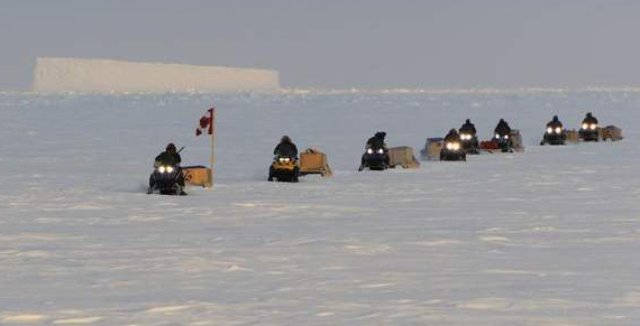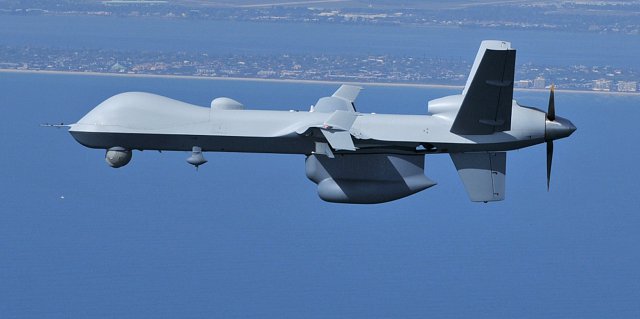 Canada’s military wants its next unmanned aircraft system to be capable of dropping search-and-rescue supplies in the Arctic and in other areas as it looks to expand UAS roles into activities formerly conducted by manned platforms.
Canada’s military wants its next unmanned aircraft system to be capable of dropping search-and-rescue supplies in the Arctic and in other areas as it looks to expand UAS roles into activities formerly conducted by manned platforms.
Canada plans to spend between CAN $1 billion (US $998 million) and $1.5 billion on a new fleet of UAS.
Lieutenant-General Yvan Blondin, head of the Royal Canadian Air Force, explained to the Senate defence committee March 25 what he is looking for in the new fleet.
“I would like to have a UAS that can carry some equipment, whether it is weapons or other equipment, to be able, when it is patrolling the Arctic, to carry a search-and-rescue package that I can drop any time I want or need to,” Blondin said.
“For UAS, we are looking at the requirement to work from home to be able to do maritime patrol, to do a bit of what the Auroras are doing and be able to patrol the coast,” he added.
Aurora maritime surveillance aircraft are a variant of the US Navy’s P-3 Orion.
UAS are also going to need great range and endurance for long patrols, and “be our eyes in the sky in the Arctic,” Blondin said.
The Air Force did not respond to questions about whether it would be willing to fund research and testing into adding equipment transport capability to UAS.
But a National Defence Department source said the Air Force hopes industry will provide solutions to Canada’s project to purchase the UAS, known as the Canadian Forces Joint UAV Surveillance and Target Acquisition System (JUSTAS)
Officials from General Atomics Aeronautical Systems, San Diego, which intends to bid on JUSTAS, said Canada’s requirements can be met without a major effort.
Scott Dann, Director of Strategic Development for General Atomics, said the firm has discussed the need for such equipment transport capability previously but has been awaiting a customer request. “All it takes is the will to do it,” Dann said. “It’s very feasible.” He said a pod, carrying up to 500 pounds of equipment, could be installed on the center portion of the company’s Predator B UAS or in smaller pods on the wings. Such a pod could contain a life raft, provisions and a radio.
“It could be self-propelled and you could motor it over to the person in distress,” Dann added. “The reason I say this is doable is because we’ve dropped small unmanned aircraft from the wings of our larger aircraft and you can actually fly them using the same data links from the ground control stations.”
Dann said if Canada was serious about such a capability, his company likely would fund research into it. “I think if we had a very serious interest, something short of a contract but serious interest, with the intent we see a likely future sale, we’d probably do it ourselves,” he said.
 For JUSTAS, the company intends to offer Canada a Guardian UAS, a maritime variant of the Predator B.
For JUSTAS, the company intends to offer Canada a Guardian UAS, a maritime variant of the Predator B.
Various options for JUSTAS are being analyzed by the Air Force but no request for proposals has been issued to industry. The Air Force has declined to discuss any delivery schedule for JUSTAS.
Companies prepared to bid on JUSTAS once a request for proposals is issued include Canadian firm MacDonald Dettwiler and Associates with a variant of the Heron UAS made by Israel Aerospace Industries.
MDA officials couldn’t say whether they would be able to provide Canada with a UAS capable of dropping search-and-rescue equipment.
A company representative noted, however, that in July 2008, MDA demonstrated for the first time in Canada the use of a UAS in a search-and-rescue role. As part of a demonstration, a Heron UAS was used by search-and-rescue personnel to perform a wide-area search, and the rescue coordinator was able to guide a ground team to a simulated crash site during the exercise.
Another potential contender is Northrop Grumman. Last year, Northrop made an unsolicited proposal for Canada to buy a fleet of Global Hawks but the government did not act on that deal.
Dane Marolt, Northrop business development director, said the company’s Global Hawk can be outfitted to carry a pod, an option that Germany used for a signals intelligence package on one of its UAS.
But Marolt said outfitting a Global Hawk, which can fly at 60,000 feet, with a search-and-rescue pod is not the way to proceed.
“If you bought [a UAS] much less capable and smaller that stayed at a lower altitude, Global Hawk could certainly cue it into the area and it could drop [the pod],” he said. “That would be my recommendation.”
The company continues to promote the Global Hawk to Canada for the Arctic surveillance mission as it has the range and endurance needed to cover such a vast territory, Marolt said.
“With one aircraft you can surveil the entire Northwest Passage four times on a single mission,” he added.
The Air Force’s quest for leading-edge UAS technology has raised some concerns. John McKay, the defense critic for the opposition Liberal Party in the House of Commons, said he is worried that adding such a capability would further delay JUSTAS, which has already fallen years behind schedule.
“It would be nice to have an all-singing, all-dancing UAS, but how much further will that delay the program?” McKay said. “I don’t know if that delay is worth it.”
A request for proposals was supposed to be issued to industry for JUSTAS by the end of 2009, with a contract awarded in the fall of 2010. Initial operating capability for the UAS fleet was scheduled for February 2012 but that is now at least five years away.
JUSTAS includes the procurement of the aircraft, spare parts, ground stations and a 20-year in-service support package.
Photos:Top -Distant Patrol: A Canadian Ranger patrol returns April 13 to Resolute Bay, Nunavut, during Operation NUNALIVUT. (Canadian Defence Forces)
Middle -Guardian – General Atomics Aeronautical Systems
Source: Defense News
